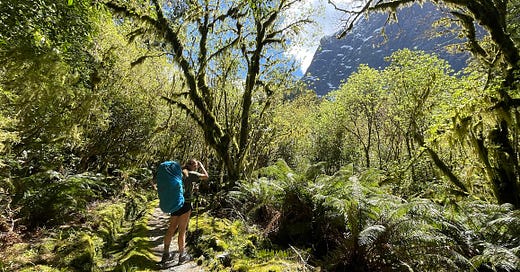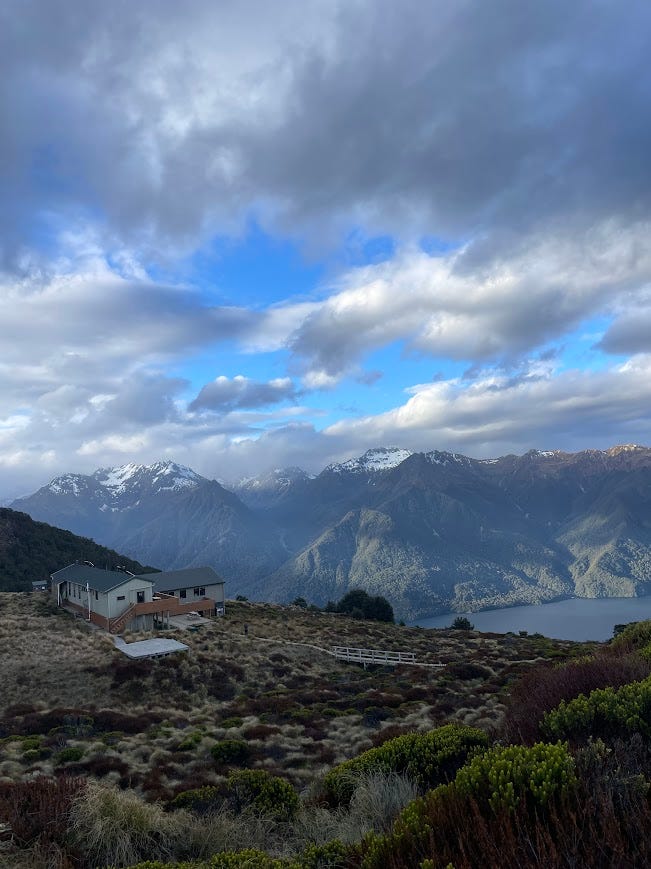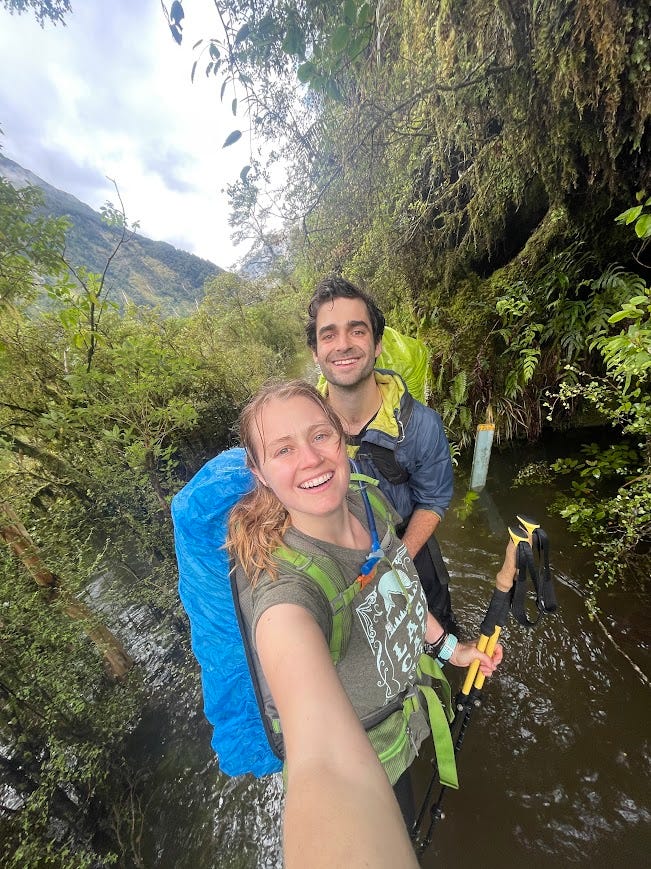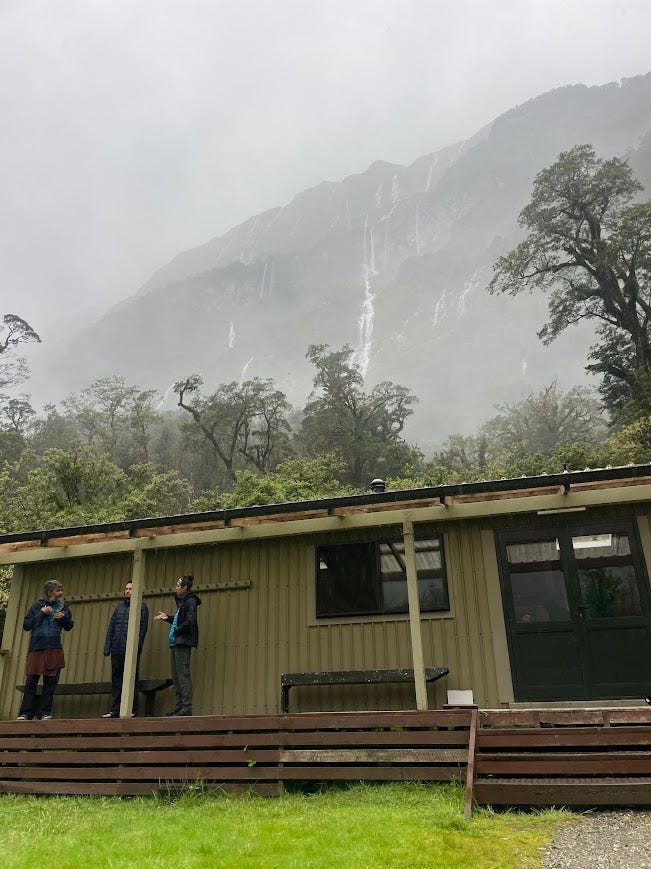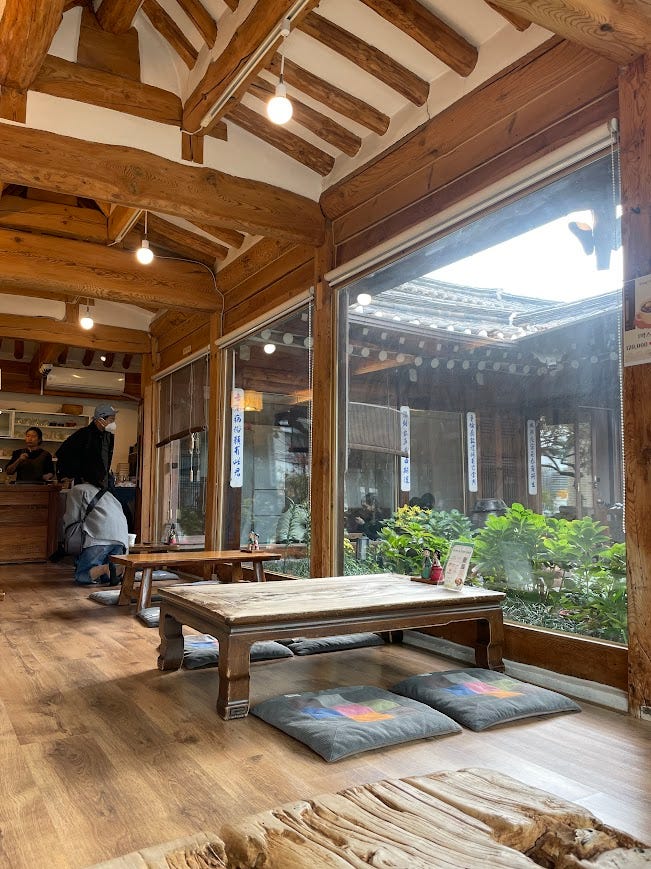The Elephant in the Hut
Highlights from the Great Walks. Plus, the unexpected gift of finding out the results of the election while trapped in a flood.
Hi from Busan!
We’ve officially wrapped up our journey in New Zealand (!!!) We finished off with two days in Queenstown doing all the non-glamorous parts of wrapping up living in another country, like canceling phone plans and continuing our eternal effort to make our luggage more compact. It was a bit of an anti-climactic end, and Queenstown isn’t really my cup of tea! Of course, it’s physically stunning, but the main activities are drinking and extreme sports that involve paying to launch yourself from great heights. We at least took advantage of having access to good food after nine days of backpacker meals that had all started to taste a bit like “same gruel, different artificial seasoning.”
But that’s not to say we didn’t have a great last few weeks in Aotearoa! With a stroke of good weather, we managed to complete both of our planned Great Walks – the Milford and Kepler Tracks. We really lucked out, as conditions can change dramatically on a daily basis, and some hikers were not able to complete their walks due to avalanche risk and flooding. All in all, we walked about 80 miles through some of the most gorgeous forest and ridgeline I’ve ever seen. Such an experience is hard to summarize, but here’s some of what I’ll remember most from the track:
The Milford Track had moss carpeting and hanging from every conceivable surface. It made me feel like maybe in a restored ecosystem we would be seeing more moss everywhere, that the absence of it should be the anomaly. A sign that it’s time for me to finally finish reading Braiding Sweetgrass so I can read Robin Wall Kimmerer’s Gathering Moss.
The Great Walks are great in part because of their incredible hut system. I’m amazed at getting to sleep indoors in such striking, remote places. The Department of Conservation does a great job of looking after trampers – the huts are equipped with gas stoves, a ranger, and sometimes even a flush toilet (luxury!)
We hiked out in a flood! Milford Sound gets 268 inches of rain per year. During our hike, it rained 12 inches in one day, which is about half of what London gets in an entire year. What this means is that hundreds if not thousands of waterfalls form spontaneously along the sheer canyon walls, and can disappear within less than a few hours of rain stopping. It also means that all that water falls down into the canyon! We were waylaid an extra day, and almost flown out by helicopter. Instead, we waded through ankle-to-knee deep water during some stretches of our 12 mile exit.
Coming from Colorado, we were familiar with avoiding avalanche risk even in summer. When we started receiving emails about a month out that our walk would be a touch-and-go decision depending on avalanche risk, we were prepared to cancel or at least break out our microspikes. But in the Fjordlands, avalanche risk looks a little different! We walked through the rainforest in shorts, while hundreds of feet above us, a seemingly small amount of snow remained. However, inclement weather can send that snow rushing down onto the track with terrifying force. DOC manages the avalanche risk to a low level and doesn’t allow hikers in unsafe conditions. However, there were still sections of the trail that were closed, and others we were instructed to move through hastily – “no stopping next 400m!”
We couldn’t leave without seeing more of New Zealand’s unique endemic birds! The kea (alpine parrot) is really crafty, and they have a specific sound they make when they find a new object to play with! We also saw the whio (blue duck), which depends on fast-moving rivers for its habitat. They launch their young into the rapids about three days after birth to teach them to swim.
Backpacking in New Zealand is so incredible that I began to feel like we should have done even more of it. We could have spent our working holiday chasing down more Great Walks, or even walking New Zealand top to bottom on the Te Araroa trail. However, by the seventh or eighth day, I spent at least half of the hike rambling about cravings for real food and how badly my feet hurt, so I think we did the perfect amount.
The Elephant in the Hut
On November 4, we took a boat from Te Anau Downs, and then began our walk into the wilderness. I knew the U.S. presidential election would be sitting in the back of my mind, and wasn’t sure if we would find out the results a week late or from a stranger on the trail. On what was supposed to be the last day of our walk on the Milford Track, the ranger woke up trampers in each bunkroom to tell us he had bad news. It had rained 200ml, and we were trapped for at least 24 hours. In the same breath, he asked “any Americans? Trump is your new president.”
We felt all of the emotions one might expect: sadness, fear, anger. We speculated about what the future would look like, and reflected on the forces leading to this moment. We talked about what it might mean for our personal lives, our careers, and our broader community. After some initial hesitation, we also talked to some of the 38 other people trapped with us: New Zealanders who had observed their own siblings becoming radicalized by far right TikTok, Canadians who are bracing for their own far right shift, and fellow Americans in the foreign service in the Philippines.
Finding out the results of a major election while trapped in a flood and cut off from the outside world sounds like an unusual experience. It’s definitely one I’ll be re-telling for a long time. But ironically, it was actually one of the more “normal” ways I’ve engaged with the news in years. Instead of being inundated (no pun intended) with takes on takes on slightly-more-nuanced-takes, we just sat with the information and processed it individually, together, and with the people around us. It didn’t feel good, and I’m certain we have some tough years ahead, but it didn’t feel as overwhelming. It felt like such a relief to not have to find out something bad, and then immediately also know what every person I’ve ever known thinks about it, and consider what I should say or repost about those events out of some sense of duty to participate in online discourse. Instead, I connected with friends and family when I got service. I read the news and reflections from writers I respect. And I continued doing what I have always tried to be doing — using my time and skills to fight for a better world. It felt freeing, healthy, and right.
-
Around the same time that I quit my job to take this sabbatical, I attended my 10-year high school reunion. What struck me most about the experience was how much I already knew about people I hadn’t seen or talked to since 2013. It felt weird asking people questions when I already sort of knew the answers. I knew that their perception of me was not based exclusively on the person they had known ten years ago, but also on all of the content I had put out about myself online since. And of course, I care about what these people think, because how can anyone ever stop caring about what your childhood friends and bullies and crushes think if you never fully disconnect from them? I genuinely enjoyed catching up with people and having them become real people to me again instead of just watching them move cities, get married, and buy homes via Instagram. But the experience unsettled me. Next year, I turn 30, and shudder to imagine what it would be like to still regularly perceive and be perceived by people I no longer talk to from previous stages of my life at 40, 50, or, god forbid, 60 and beyond.
This year, I have worked to recalibrate so many aspects of my life (ref: this entire blog!), but clawing back my relationship to social media has been one of the slowest. And understably so! I have been curating what Naomi Klein calls a “digital doppelgänger” since I joined Facebook in ninth grade, and even more incessantly since Instagram stories launched during my senior year of college. My sense of self has developed inextricably alongside the dopamine and anxiety that social media produces. Like everyone else, I’m aware of the harms of social media, both for myself and society. Like (almost) everyone else, I’ve continued to engage with it on a near constant basis. At times, I’ve convinced myself I have control over my relationship to it, that I’ve harnessed the positives and minimized the negatives. But I no longer believe this is possible. Passages in books I’ve read this year have really disturbed me – a tear-jerking chapter on the rage-baiting of the algorithm to make money by straining a father-son relationship in Nathan Hill’s Wellness, the inescapable reminders of better ways we could be spending our time in Oliver Burkeman’s Four Thousand Weeks, and the ceaseless performance of our “personal brands” in Doppelgänger. I’ve finally experienced the power of disgust that has been used in an intervention for smokers where “the idea is that you keep smoking while you read about how bad smoking is. Eventually the cigarettes begin to seem disgusting.”1
Spending a year living abroad has amplified some of the stressors I already felt around my own performance of my digital self. I’m spending time in beautiful places and having incredible experiences, and my brain prompts me to get even more dopamine by sharing about it on social media, a pattern it has learned for over 15 years! In comparison with previous years, I haven’t used social media as frequently to post about issues that I care about, even as I’ve continued to engage with them. I often wonder (read: worry) if the politically engaged people in my feed think that I’ve just blown off to hike in New Zealand, am suffering from main character syndrome, and don’t care about what else is happening in the world. When we emerged from the woods, I did silly calculations in my head about things like whether it was acceptable to post about our backpacking trip without posting about the election. I felt stupid for caring about that, but also aware that I’ve been conditioned to care about it! I felt disillusionment that an app where I post fun pictures of my hike is the same space where I receive and share information about social and political issues, even if I also understand that these things can’t always be separate in a world where everything is political. I wondered what people would think of my actions, while also knowing it was weird and egotistical to imagine they were thinking of me at all. Describing people my age, Klein attributes this to having “grown up with an acute consciousness of an externalized double—a digital double, an idealized identity that is partitioned from their “real” selves and that serves as a role they must perform for the benefit of others if they are to succeed. At the same time, they must project the unwanted and dangerous parts of themselves onto others (the unenlightened, the problematic, the deplorable, the ‘not me’ that sharpens the borders of the ‘me’). This triad — of partitioning, performing, and projecting — is fast becoming a universal form of doppelganging, generating a figure who is not exactly us, but whom others nonetheless perceive as us.” It’s an unwinnable mind game with imaginary referees.
People try to quit social media all the time. The fact that people even announce their departure from social media further re-emphasizes how seriously we take the performance of our digital selves. Leaving doesn’t necessarily get you out of the performance, either. As Klein learned when she became the face of her No Logo movement in the 90s, even the choice to opt out can become its own performance and personal brand. Even so, I’ll take that performance over the one I am currently cultivating on a daily basis while taking cues from hundreds of people who I’ve known throughout my life. Prompted by our hut experience, my reading, and discussions with friends, I am finally taking actual steps to limit and eliminate my social media. I acknowledge that social media is designed to be an addiction, and one that I might not be able to kick in one go. It’s also embedded in many parts of my life, including things I plan to keep doing, like tracking my workouts and writing this blog. But this is a meaningful change I want to make before I transition back into my post-recess life, before familiar stressors push me back into old habits. As I do so, I’m continuing to think about questions like:
What does it mean to show up for my community while I am physically distant, or when my community is dispersed?
What sources of news/information do I want to consume from both traditional and non-traditional media sources, where I was previously finding these through social media?
When and how do I want to engage with this information, if the answer is no longer literallyallthetimeevenwhenIwasn’tplanningonit?
What are the best ways for me to build community in the next place that I move, when I have traditionally relied on social media to reconnect with old friends or find organizing spaces/political action groups?
How can I continue to peel back my “true self” from the doppelgängers we create, both offline and online, and the tendency it creates to view ourselves through a third person lens?
This shift feels like a big piece of my effort this year to curate better self-esteem, which continues to dog me even as I develop better habits and challenge old beliefs. I’m optimistic! And even though Substack is quickly morphing from “what began as a creative underground sandbox (or at least what began as something that felt that way) to another greedy, feedy, social media platform,” I’m still grateful for how it has allowed me to connect with people and ideas in meaningful ways.
What’s Next?
After a flight to Korea that felt short by US-to-NZ standards, we had a truly lovely two days exploring Seoul, which felt like barely scratching the surface. We treated ourselves to a little bit of luxury after two weeks of hostels and huts! We relaxed in a tea house, had a traditional temple meal, and went to a bathhouse for a body scrub. We took our first high-speed train (!) to Busan, where we’ve been settling into our volunteer stay. Lots more soon on transitioning out of the working holiday into a different type of travel, and what our time looks like in South Korea!
Quoted from the introduction to another non-fiction read that has really impacted me this year: Ultra-Processed People: The Science Behind Food That Isn’t Food.

